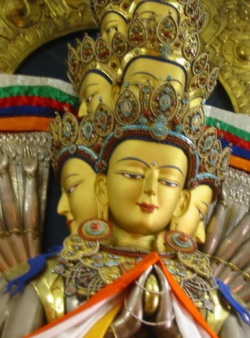Book of Ceremonies
by Lin Wanchuan
One of the expository scriptures of the Way of Prior Heaven (先天道), a new Religion of the early Qing (清) period. It was written by a low-ranking preacher in a Buddhist hall in order to win converts and instruct them, and propagate his Religion. As the Book of Ceremonies was written in the period when the Cult of Heavenly Gratitude was popular, it had to be accepted by the former, owing to which it is also known as The Scripture of the Book of Gratitude (恩本經) and The Book of Gratitude-led Ceremonies (領恩禮本). Over the Conversion ceremony, the preacher had to explain and clarify the rationale for entering the Way, meaning, vows, rules, and other commandments, and so was also known as the Expository Scripture (開示經).
In the late Ming and early Qing period, Huang Dehui (黃德輝), a figure within the Complete and True Way made use of the “Eternal Birthless Mother (無生老母),” popular at the time, and to create the Way of Prior Heaven and publish the Book of Ceremonies in1667 (6th year of Kangxi [康熙] Emperor). The book’s content was taken from the Precious Verifiable of 9-Lotus Scripture of Finding Buddha (皇極金丹九蓮證性皈真寶卷), Scripture on Garland Compassion and Precious Repentance (慈悲懸華寶懺), Precious Scroll of the Tathagata’s Key (普靜如來鑰匙寶卷) and other scriptures from new religions compiled in the early Ming (明). The Liben Zhujie, Wanan Guize Hebian (禮本註解、萬安規則合編) states that: “Rectifying and practicing dao is the necessary root of the reader of the Book of Ceremonies”. It has also been revered as a secret book. Prior to the beginning of the Ritual of Universal Salvation (普度), until after it has begun, the protection of the ten peaks and proof of Heavenly Gratitude, whose ceremonial incantations are not contained within this book.” All of the Ritual rules and religious doctrines of the Way of Prior Heaven are contained within this scripture. The compilation of the Book of Ceremonies shows that the Refined Golden Boat was considered the core tenant of the Religion, and a gateway to the Religion dressed as a new Religion produced, which gradually developed into one of the mainstream religions of China in the 19th century, and by the 20th century had spread to south-east Asia, Japan, and Korea.
The content of the Book of Ceremonies can be summarized as follows:
(1) Burning Incense and sacrificing to the gods: revering the Eternal Birthless Mother of the Jasper Pool (瑤池金母), the Maitreya Buddha (彌勒阿佛) and Eightfold Path of the Heavenly Dragon (龍天八部), as well as the past Buddhas, ancestors at the Altar;
(2) begging to ascend: reflecting heavenly grace on people, and praying to ascend;
(3) Expressing heavenly grace: since time immemorable, the masses have been lost, and become mired within the cycle of Death and Rebirth. Now, fortunately, they have come across the Dragon Flower the end of the Kalpa (龍華末劫), general salvation of the dao, and should learn from the Dragon Flower at Dizang Wang (地藏王, Ksitigarbha) and other immortals, and make the masses willing to practice dao;
(4) Become Buddhist and establish Desire: become willing to study Buddhism and accept the 3 rules and 5 prohibitions, follow the great and true Buddhist scripture of the final Kalpa, illuminate their minds and see nature, and surpass Life and Death. Those who break these rules should submit to the censure of Heaven and punishment of thunder;
(5) Pray for salvation and repent; Heavenly grace forgives men all of their offences throughout their countless years in the cycle of Life and Death, and the government and population, celebrate Heaven’s name, and pray that the 3 Calamities and 8 Difficulties do not attack;
(6) By directing Incense smoke towards the converts, Heavenly grace signifies that they have been anointed, then they are anointed on their “elixir field” to “show Life”, then the Mysterious pass to “show the way.” This is considered the most important part of the ceremony; (7) Thanks are expressed to Heaven and the ceremony ends.
The Way of Prior Heaven first spread to Hsinchu in 1855 (5th year of Xianfeng [咸豐] Emperor), after which over 70 halls were founded over the next hundred years; over the Japanese Colonial Period, the sect was designated the “ Prior Heaven School, a Vegetarian Sect.” After the Second World War, it joined the Buddhist Association and changed its name to the “Buddhist Prior Heaven School.” As it required followers to become vegetarian and renounce their worldly Desires, it was not easily accepted, and all but disappears in the later 20th century.
After undergoing hundreds of years of change, the Book of Ceremonies as used by the Yiguan Dao (一貫道, Unity Sect ) has now been simplified into two parts: the Scripture of Praying at the Altar (請壇經) and Terms of Defining the Way (點道詞).
Chinese Keyword
新興宗教 , 先天道 , 天恩 , 龍華末劫 , 玄關
English Keyword
new religions , Way of Prior Heaven , heavenly grace , Dragon Flower at the end of the Kalpa , Mysterious pass
References
Liang, Yunxian. (1950). Li ben zhu jie: Wan an gui ze he bian [禮本註解:萬安規則合編]. Hongkong: Kowloon Society for The Promotion of Virtue , Lung Hing Tong , Ltd.
Lin, Wanchuan. (1984). Xian tian dao yan jiu [先天道研究]. Tainan: Tianju.
Feng tian cheng yun pu du shou yuan zheng zong dao tong bao jian [奉天承運普度收圓正宗道統寶鑑]. (1974). Taipei: Wan you shan shu.
Mu, Yu. (2002). Yi guan dao gai yao [一貫道概要]. Tainan: Tian ju.
Wang, Chienchuan. (2007). Xian tian dao chuan tong de xing cheng yu dao mai yuan liu xin lun [先天道”傳統”的形成與道脈源流新論]. In Xian tian dao li shi yu xian kuang yan tao hui lun wen [先天道歷史與現況研討會論文]. Hongkong: Certificate Programme in Daoist Culture, The Chinese University of HongKong.

